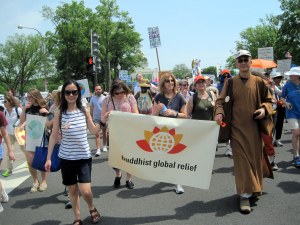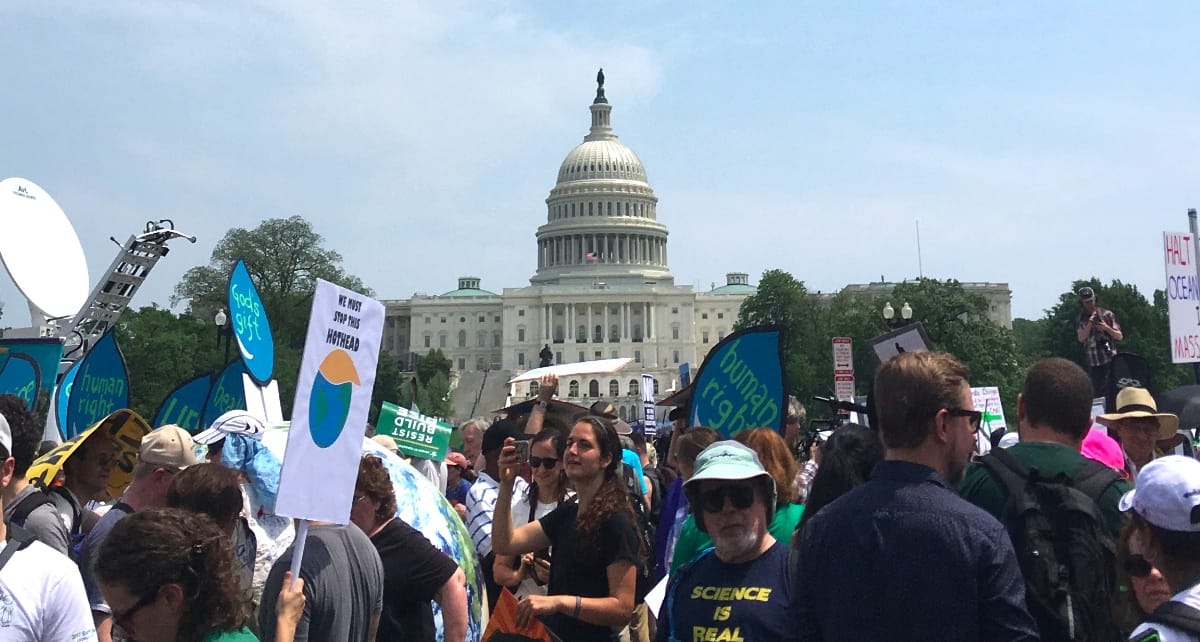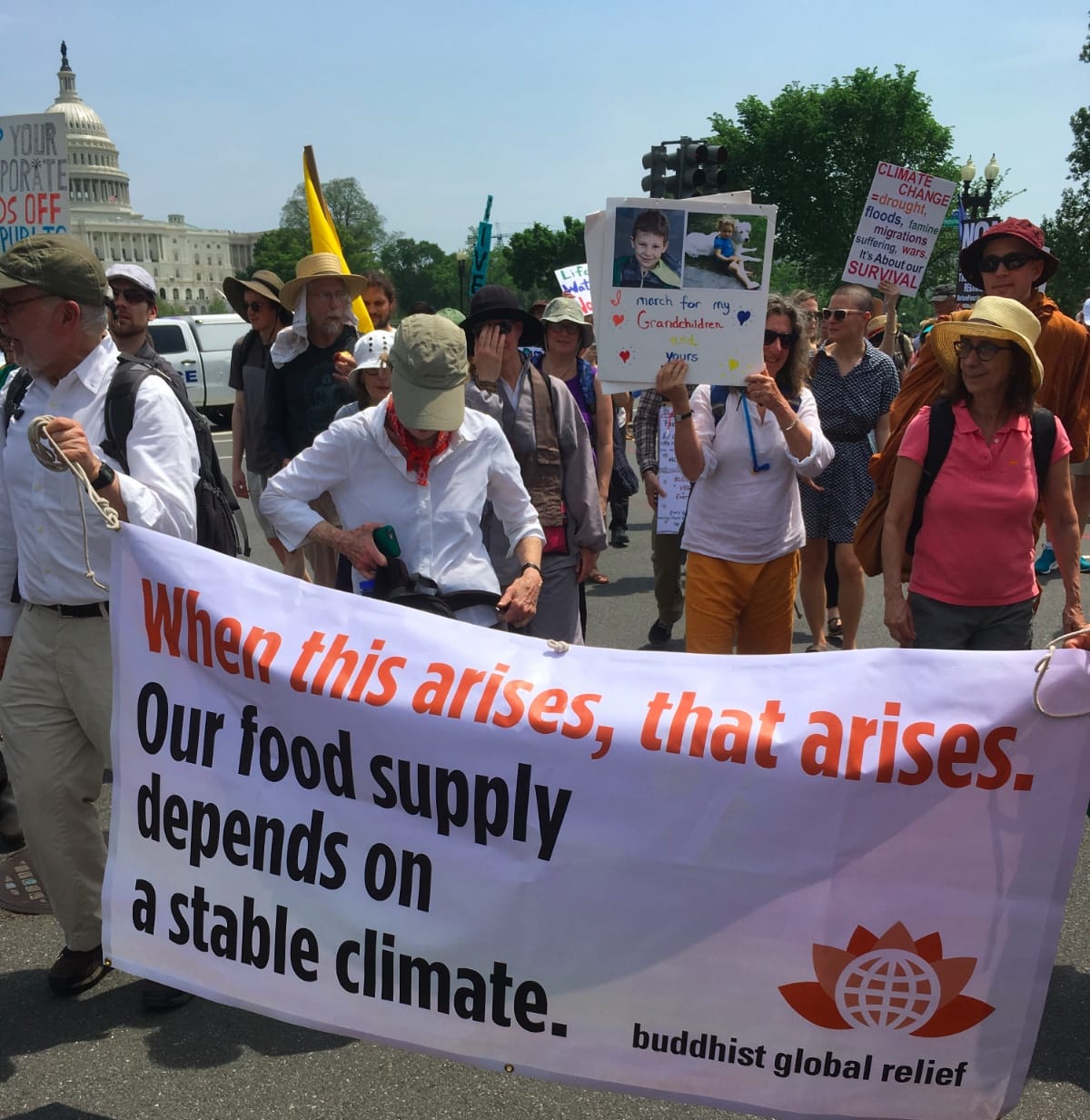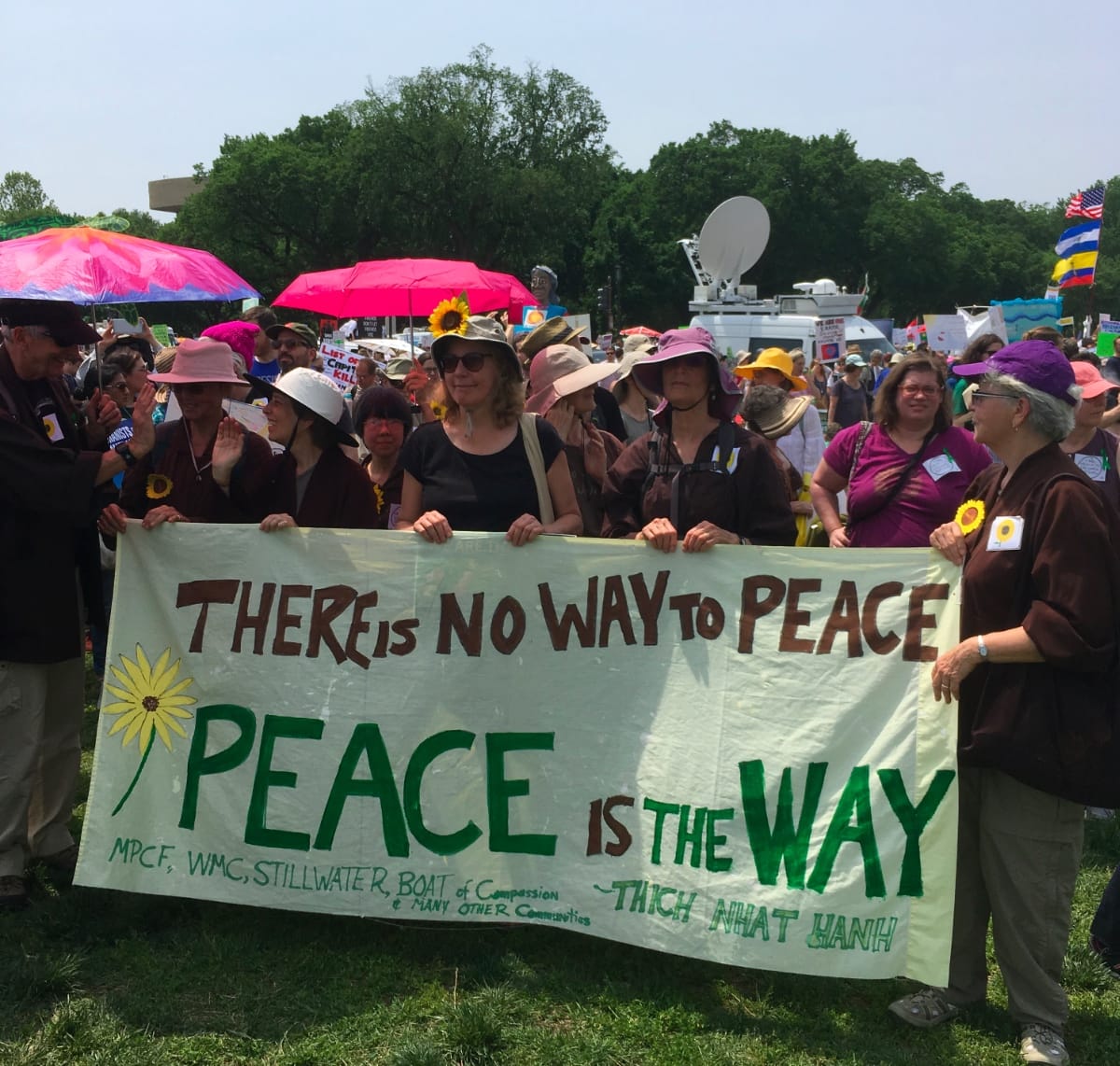A “Rolling Retreat” of dharma teachers and practitioners, by the busload, helped Buddhists to join Saturday’s People’s Climate March in Washington, D.C.
Stepping off the Buddhist retreat bus in D.C. on Saturday, two things were apparent: the 2017 People’s Climate March was going to be huge, and it was going to be hot. The record-breaking 92-degree heat seemed to enhance the energy of the staggering crowds that had convened to march from the foot of the Capitol Building to surround the White House.
I’d chosen to march with the Buddhist contingent as part of the Faith Bloc, situated between the Science bloc and Fossil Fuel resistance groups that gathered to surge down Pennsylvania Avenue. It was Trump’s 100th day in office, and over 200 Buddhists from around the world had shown up to make their voices heard with another 200,000+ people. The common message was clear: we know the climate is changing, and we want to address this.
The 2014 People’s Climate March in New York had been a groundbreaking moment for inter-sangha cooperation. While it wasn’t out of the ordinary to see politically engaged teachers like Bhikkhu Bodhi and Roshi Pat Enkyo O’Hara at a demonstration, coordinated action was relatively new. Representatives of various sanghas and concerned practitioners stepped up. Bob Kolodny, who practices at New York Insight and coordinates the New York chapter of the Buddhist Climate Action Network (BCAN) would use many of the connections he’d developed at that time to contribute to Bhikkhu Bodhi and Regina Valdez’ vision of a whole new form of engagement for the 2017 version of the march. “We’re seeing people galvanize across the country to face a number of issues. I don’t think the Buddhist community is that different. People are concerned and want to respond,” Kolodny told me. He also credits Bhikkhu Bodhi and David Loy for helping people realize that taking action is consistent with Buddhist principles. “More and more people have been inspired to take action. It certainly seems like a threshold has been crossed,” he said. What the Triple Gem retreat offered was a space to be in solidarity with other Buddhists from various traditions and take our practices out of the meditation center and into the world.
I found out about the “Triple Gem Rolling Retreat” through a BCAN email. There would be four buses, each led by a renowned Buddhist teacher who would offer teachings and give a sense of ceremony to our trip from New York. I felt motivated to attend the march because I believe it’s important to get out from behind my laptop and be in the presence of others who want to address the huge social and environmental issues of this era. I also try to treat each demonstration, each rally, and by extension each moment of my life as an opportunity to bear witness. The Zen Peacemakers’ three tenets are something I try to live by, where we empty our minds of preconceived notions, bear witness to suffering, and then transform that suffering through compassionate action.
What the Triple Gem retreat offered was a space to do all this in solidarity with other Buddhists from various traditions, so we could share our different interpretations of each principle, and help build a case for taking our practices out of the meditation center and into the world.
Members of Buddhist Global Relief at the Washington, D.C. People’s Climate March, 2017. Photo by Caroline Contillo.
The bus caravan to DC was organized by Regina Valdez, outreach coordinator for Bhikkhu Bodhi’s organization, Buddhist Global Relief. A practicing Buddhist of eight years, Valdez had become concerned with what she perceived as a need for Buddhists to engage their practice with social and environmental issues. The idea for a rolling retreat, with Buddhist teachers and monastics giving a sense of ceremony to a trip to the Climate March, stemmed from her group Compassion NYC, which she founded to implement the Buddhist Global Relief missions of economic and climate justice on a local level.
“I thought it would be wishful thinking, to have this rolling retreat to Washington, but it’s been a trip! A day and night mission,” she told me over the phone before the retreat, which she had been working on since January.
I gravitated to Buddhist practice to grapple with the despair I felt after learning about climate change. I had studied climate science, the history of its discovery, and its presentation in science journalism as an undergrad at Hunter College. I was left feeling that I’d need not just a meditation practice but an ethical framework to confront my fear about the future. Buddhism offered very practical and elegant tools for this endeavor. Through an understanding of my own suffering, I could connect to others and work to let go of my tendency to project stories of worry into the future. After changing my relationship to myself, I could relate to the world in a way that was less driven by the momentum of anxiety and even work to help alleviate the suffering caused by social and environmental justice.
I gravitated to Buddhist practice to grapple with the despair I felt after learning about climate change. I had studied climate science, the history of its discovery, and its presentation in science journalism as an undergrad at Hunter College. I was left feeling that I’d need not just a meditation practice but an ethical framework to confront my fear about the future. Buddhism offered very practical and elegant tools for this endeavor. Through an understanding of my own suffering, I could connect to others and work to let go of my tendency to project stories of worry into the future. After changing my relationship to myself, I could relate to the world in a way that was less driven by the momentum of anxiety and even work to help alleviate the suffering caused by social and environmental justice.
Climate change is on one hand framed as a problem we can overcome by finding the right solutions and by showing up at protests. On the other hand, the climate is the very thing we live within, and touches every aspect of our lives. It is an intricate network of feedback loops and interconnection. It points to the fact that no issue is actually isolated. In Buddhist practice we call this interdependence. In social theory, the term intersectionality has gained popularity, pointing to the way that no social issue or aspect of identity exists in isolation. What I’m sensing is that we are becoming more able to think in terms of systems, and understanding climate change can be a catalyst for that.
Reverend angel Kyodo williams, the second black woman to be ordained as a teacher in her lineage, led a retreat bus for people of color and accomplices, a word that references more active participation than the conventional idea of being an ally in the struggle for justice. This explicitly intersectional approach to the march and to Buddhist practice took the principle of interdependence and asked us to make it concrete by acknowledging that people of color and indigenous people are disproportionately impacted by climate change and environmental racism. The changing climate touches all of us — but some people are more vulnerable to the harm it causes.
The morning of the march we lined up at 6am along 34th Street in Manhattan, checking in with a well-organized team of head teachers, bus captains, and other volunteers. I was assigned to Roshi Enkyo O’Hara’s bus. Buddhist Global Relief provided us with breakfast bags and instructions for what to do once on the ground in DC. After a DVD introduction to the Rolling Retreat featuring Bhikkhu Bodhi’s impassioned plea for compassionate action, Enkyo spoke to the politically engaged nature of her tradition, Soto Zen. Teachings continued throughout the four-hour bus ride, including commentary from Reverend T.K. Nakagaki of the Buddhist Council of New York, Michele LaPorte of the Shambhala and Vajrayana Buddhist traditions, and Reverend Doyeon Park of Won Buddhism New York. It was a unique opportunity to hear a number of Buddhist perspectives on the necessity of engaging Buddhist practices to confront what Bhikkhu Bodhi explained as a challenge and crisis that faces the entire global community.
We had the opportunity to share with each other about our own practices and a little about the things that motivated us to participate in the march. Some common themes included a desire to ensure a hospitable climate for future generations and a commitment to being with others who have similar values. As my bus neighbor Marilyn Ivy, an anthropology professor at Columbia University, said, “being around other people makes confronting these challenges seem more doable.”
Many different Buddhist traditions were represented on my bus alone, including Pure Land, Chan, Won, Shambhala, Nyingma, and we were joined by a member of the Baha’i faith. Some wanted to be actively engaged in democracy, and there were monastics on the bus who said that as people of conscience, they wanted to make sure Trump knew that his actions were being witnessed. The common thread was feeling the need to respond to the climate emergency from a place of compassion.
Venerable Bhikkhu Bodhi, with fellow marchers, protecting himself from the hot sun at the Washington, D.C. People’s Climate March, 2017. Photo by Caroline Contillo.
Heading towards the starting point from the bus parking lot, the sheer volume of the march was striking. The streets and the sidewalks around the National Mall were packed shoulder to shoulder before we began marching. The density of the crowd made it difficult to stay together as a consolidated group so, once the march started, I moved through the crowd, attempting to talk to different factions within the Buddhist contingent. Aside from the participants who’d come from New York, I was told there were over 200 other Buddhists who had come from as far as Japan and Taiwan for the march.
I had the opportunity to ask Bhikkhu Bodhi what he felt the Buddhist basis for participating in the climate march might be. Under the intensity of what felt like a summer sun in August, he spoke about what equanimity means. “Equanimity does not mean withdrawing from all the events taking place in the world and cultivating indifference,” he said. “True equanimity should co-exist with the wisdom of cause and effect. Through wisdom we understand the causes of suffering and out of compassion we are motivated to act in ways that will eliminate those causes at different levels.”
At 12:30, we began marching. Sometimes I’d find myself having fallen behind amongst the Quakers and Mennonites. When I’d try to catch up with the Buddhists I’d go too far and end up in the midst of the Science Bloc. This ended up being a beautiful pilgrimage in itself, a tour of different ways of relating to the crisis of climate change.
At 2 o’clock, we all sat down to perform a “collective heartbeat” by tapping on our chests. Or at least, that was the plan. Due to the size of the crowd and the swiftness of the collective action, I missed that part, but we all managed to get back in synch and let out an enormous roar. “This is a sense of solidarity we rarely experience,” a woman behind me said to her march companion.
The ride back to New York was more subdued, with chanting at sunset by Reverend Nakagaki, and a reading by Michele LaPorte of the Sadhana of Mahamudra. We talked to each other about action points and next steps, urged by Roshi O’Hara to consider the “bonds of spiritual friendship” forged on our pilgrimage.
In the hopes of stoking the energy of a growing Buddhist climate movement, Bob Kolodny encouraged us to act as point people for our home sanghas. If each of us volunteered to announce information about future actions related to the climate, we could take what Roshi called the good feelings cultivated on this march and integrate them with the necessity for resistance.
Debra Keehn, who practices at Zen Center for Contemplative Care in New York, mentioned the idea of bringing our Buddhist principles with us to other sorts of political action and civil society group meetings. Her feelings about the march captured what many of us felt: “very grounding, despite the heat!” As the motto for 2014’s climate march said, “to change everything, we need everyone.” If Buddhist practitioners and other meditators are willing to bring our practices to meet the crises of this era, I think we stand a chance of meeting this moment of extreme change with a unique set of tools and a grounded perspective.
This article originally appeared on the website Lion’s Roar here. It is posted here with permission of the publisher.
The author, Caroline Contillo, completed the Dharma Immersion Program at the Interdependence Project in 2011. She has been interested in using the lenses of mindfulness, improv comedy, direct action, and science fiction to see how we might co-create a just and joyous world. She teaches meditation at MNDFL, a new studio in Lower Manhattan. She lives in Queens, and invites you to check out her personal site spacecrone.com or follow her on twitter, @spacecrone.






